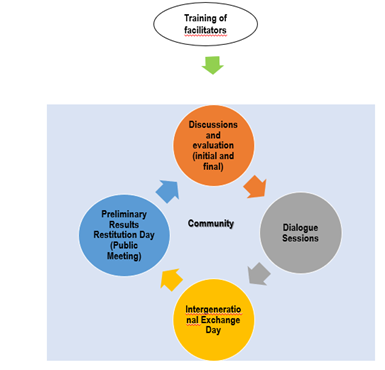2. The Principles of the Community Gender Transformative Approach
The Community Gender Transformative Approach is based on the continuum of change: How do we create change at the level of this Community Gender Transformative Approach?
This change is materialized through 4 principles.
- Involvement: involving means consulting the communities on the place, the date, the construction of the content of the community dialogue sessions, à they feel involved insofar as we have shared with them all the steps and we have asked for their opinion throughout the preparatory phase of the community dialogue sessions.
- Participation: communities participate in the sense that they take part in discussions on all these themes mentioned above; they give their opinion during dialogue sessions, their opinion is valued and considered. Communities also participate in the sense that they identify community challenges related to the problems identified (GBV, FGM, etc.) in the community and propose solutions. This participation manifests itself through individual commitments, commitments at the family level and at the community level, including with elders, leaders and other administrative authorities. By doing so, it makes it possible to identify actions for each community partner and to make the implementation of community dialogue sessions in living spaces more concrete.
- Empowerment: that is, people will practice what they have learned during community dialogue sessions on socialization, gender-based violence including FGM, sexual and reproductive rights, etc., in their family, their services, their group and in the community.
- Ownership: this is carried by the participant and manifests itself through peer awareness. Indeed, by following these four principles of the gender-transformative community approach, communities, including men and boys, who have participated in the entire process of deconstructing harmful social norms and gender norms during the dialogue sessions are able to raise awareness beyond their communities. This is called ownership because the people involved become the bearers of the voice of change beyond their community.
“As a community actor, our intervention is limited to participation. Between empowerment and ownership, we have to be accompanists because housing is carried by the participant himself who takes the lead, usually in a natural way. It is at this level that the participant has clearly understood the outcome of the community dialogue sessions on socialization, FGM, gender-based violence, etc., and is able to convey a progressive message to the people around him and other communities surrounding the events of daily life (weekly markets, ceremonies)” Fara, COP webinar speaker September 2023, The Gender Transformative Community Approach.

Once the participant has been able to do this through these different phases (involvement, participation, empowerment, ownership) they are said to have taken ownership of the gender-transformative community approach and are an ambassador who contributes to challenging social and gender norms that are harmful to girls and women, such as FGM.
3.The steps of the Community Gender Transformative Approach (ACT)
a) How does it work?
The ACT approach consists of training facilitators from the communities concerned who will lead dialogue sessions in non-mixed gender and generational (in order to promote discussions) who will discuss the relationships between men and women, the way in which we have been socialized, questions of sexuality, pleasure (to make the link with the impact of FGM), sexual and reproductive rights, gender-based violence. Dialogue sessions take place every 15 days. During this period, participants are invited to speak with at least 5 people from their neighbourhoods to disseminate the messages and thus have an impact on the community.
Once the 7 dialogue sessions are over, the 4 groups are invited to regroup, mix to share what was easy, difficult during the sessions, what it changed on an individual level, in their family or in their community. Together, the participants prepare important messages to convey to the local authorities and a feedback day is organised with the authorities where the participants take the floor. The authorities are also invited to give their commitment since some actions and recommendations are at the institutional level.
The results of the activities are then shared at the national level during the coordination meetings of the national platform to fight for the abandonment of FGM and GBV to promote the scaling up of the approach.
The 3 steps of the ACT approach:
– Step 1: Cycle of 7 community dialogue sessions with 4 different groups (8 married men, 8 unmarried young men, 8 married women, 8 unmarried young women)
– Step 2: Days of exchanges between the different groups in gender and generational mix with the 4 mixed groups (1 day) and the organization of a restitution workshop with key local actors (1 day)
– Step 3 : National Feedback Workshop
b) Thematic content of the Community Dialogue Sessions
The 7 community dialogue sessions of Phase 1 of the ACT approach address the following themes:
- Session 1: What is a man, What is a woman (difference between sex and gender)
- Session 2: How we are socialized, what role is expected of us
- Session 3: Sexuality, Family Planning, Intimate Hygiene
- Session 4: Excision and sexuality, notion of pleasure
- Session 5: Sexual and Reproductive Rights
- Session 6: Gender-based violence
- Session 7: How to Prevent Violence: Managing Emotions, Dialogue
c) Facilitate community dialogue sessions

d) Some guidelines for Gender Transformative community dialogue sessions to end to female genital mutilation and gender-based violence.

4. Once all the topics have been covered during the dialogue sessions, what happens next?
Once all the themes of the community dialogue sessions have been completed, two major days of dialogue are organized. One with all the community members who participated in the community dialogue process (1) and another aimed at reporting the preliminary results at the local level (2).
a) Organization of the Gender Dialogue Day
This day:
- Serves as a space to facilitate the meeting and sharing of experience between participants in dialogue sessions;
- It then presents the changes made at the individual level and in the immediate environment of the participants in the dialogue sessions; Each group takes the floor and shares what they have learned from the other groups. It is also a way to initiate and promote gender dialogues where men, women, boys and girls discuss gender representations within the community;
- Finally, it makes it possible to present and agree on the requests/recommendations that will be addressed to the community partners (the local and administrative authority, religious leaders, security, etc.) during the day of restitution of the preliminary results. Each group makes requests and recommendations to local authorities, religious leaders and teachers.
b) Preliminary results feedback day at local level
The objectives of this day are to:
- Render the preliminary effects of the dialogue sessions at the individual level and in the immediate environment of the participants in the dialogue sessions;
- Present to the authorities, the commitments and recommendations of the participants in the dialogue sessions;
- Present the results of the project to key stakeholders at the central level;
- Present lessons learned;
- Share best practices;
It is addressed to local and administrative authorities; Sectoral authorities (health, justice, security, religious, education, media, leaders of groups and associations, etc.), all actors involved in GBV and FGM issues are invited.
5. Success and challenges of the Community Gender Transformative Approach
a) Success of the Community Gender Transformative Approach
- With the Gender Transformative Community Approach, we only address the issue of Female Genital Mutilation (FGM) and gender-based violence after understanding the difference between sex and gender, having become aware of how we were socialized as a boy and a girl… So we go back to the root, the basis of power inequalities.
- Community Conversations with a Popular Education Method: With the Gender Transformative Community Approach, we call on collective intelligence, empowerment, participatory method
- A “safe” framework that frees speech and ensures safety: non-mixed group (age, gender), non-judgmental, possible to talk about sexuality without taboos
- With the gender-transformative community approach, we highlight operators who know the region well, the community approach, gender-based violence including FGM
- Highly supportive and involved regional and local authorities
b) Challenges to the Community Gender Transformative Approach
- Many people still attached to beliefs in the minds, witchcraft in Guinea Forest with people who fear to have a bad fate if they stop excision.
- Duration of the approach: For short projects (3-4 months) this approach is not recommended.
The ACT approach must be followed by a comprehensive intersectoral approach (health, justice, police, education, arts). A gender approach and the deconstruction of stereotypes must take place at all levels of decision-making. Gender is a cross-cutting issue that affects all ministries and all levels of government responsibility. It is a political decision, a societal choice, which cannot be left to individual responsibility alone. For instance, if female genital mutilation goes unpunished, if women who are victims of domestic violence are not heard in police stations, if a widow is forced to marry her dead husband’s brother, if priority is given to boys’ education, it will be very difficult to change the frame of reference and the inequalities between men and women that are at the root of gender-based violence.




